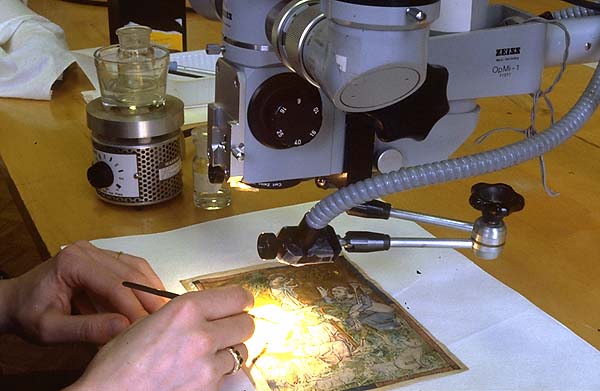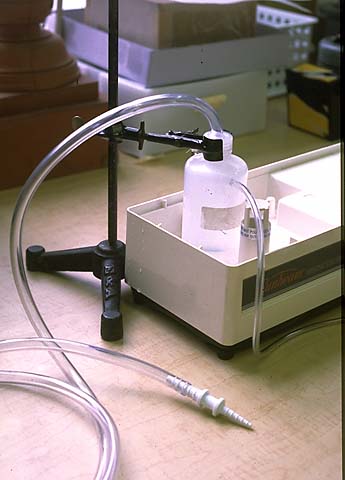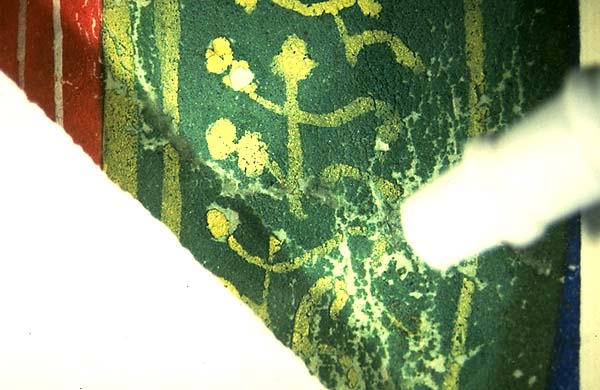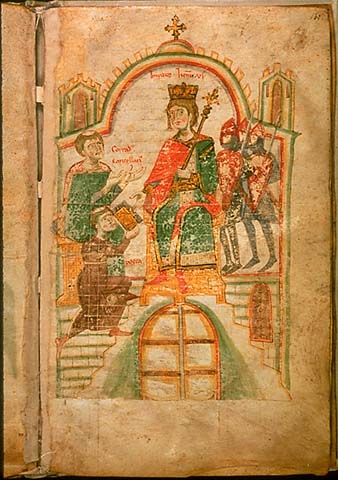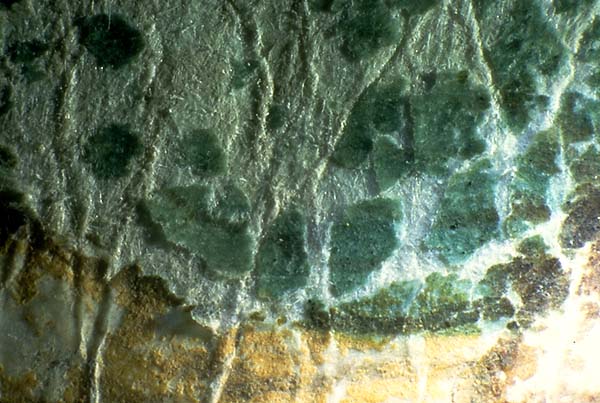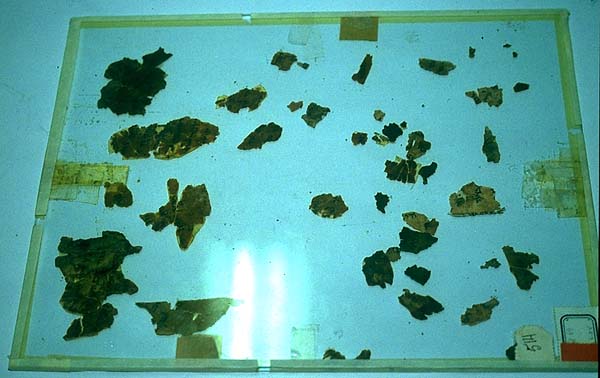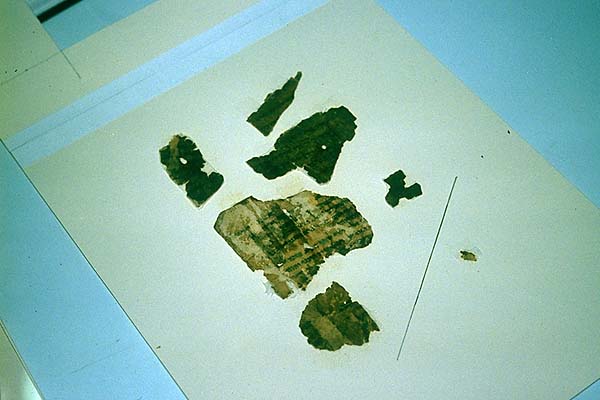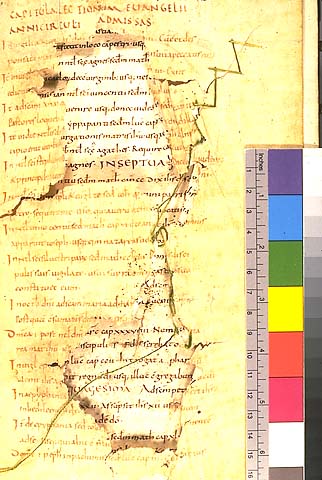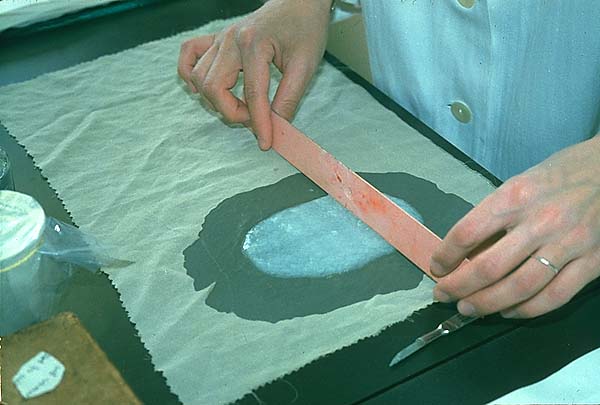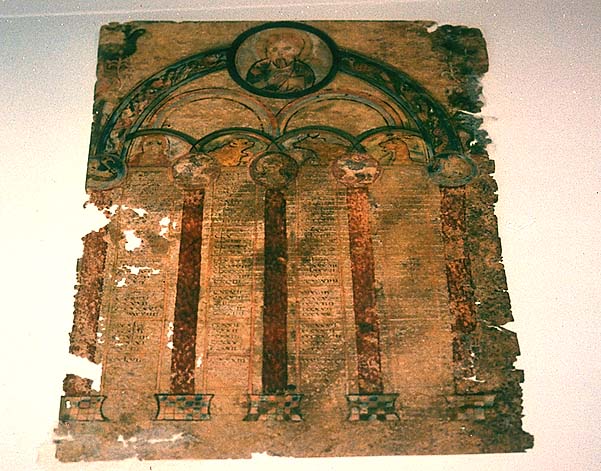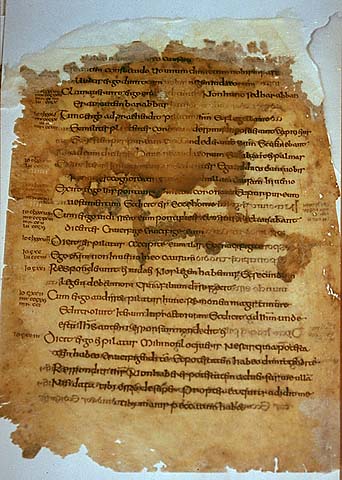Recent Developments in the Conservation of Parchment Manuscripts
by Abigail B. QuandtOver the past ten years many new developments have been made in the field of parchment conservation both in the U.S. and abroad. Three of the most exciting developments have occurred in the areas of media consolidation, humidification, and repair. While some of these new techniques have been developed by conservators and scientists specifically for the treatment of parchment, many methods have been adapted from the closely related field of paper conservation.
Media Consolidation
Flaking and friable media on parchment can be a challenging problem, especially if the manuscript is still in bound form. The paint and/or writing ink can be unstable for many reasons including: improper preparation of the parchment surface or the media itself; desiccation of the binder upon ageing; abrasion to the paint surface; stress caused by excessive flexing of the parchment support; or inherent instability of the media. The aim of any consolidation treatment is to arrest the flaking process and to ensure that no further loss occurs. The consolidant should be compatible with both the media and the support, should not create any visual change in the area being treated, and should have good ageing characteristics. In addition, the technique for applying the consolidant should be highly controllable such that the surrounding media is not disturbed and only the minimum amount of consolidant is deposited on the flaking paint or ink.
In the early 1960's conservators at the Walters Art Gallery became increasingly aware of the poor condition of the illuminations in many of the museum's 800 manuscripts and they felt that urgent stabilization treatment was needed. After consulting the British conservation scientist Anthony Werner on the most appropriate material to be used for paint consolidation soluble nylon was selected by the Walters conservators and was used for this purpose for the next 15 years.1 In 1977 visiting book conservator Christopher Clarkson recommended that the use of soluble nylon be discontinued due to recent concerns that had arisen among conservation professionals regarding the material's long term stability and its suitability for media consolidation.2 During his brief tenure at the Walters Mr. Clarkson introduced the practice of using a dilute solution of parchment size for the consolidation of flaking paint in parchment manuscripts.3 This new technique was adopted wholeheartedly by the other conservators at the Walters, who used it with success for the next 17 years. More recently leaf gelatin, instead of parchment size, has been used for media consolidation at the Walters. This change in approach is due to heightened concerns about certain organic pigments, frequently found in medieval manuscript illuminations, that could be adversely affected by a solution of parchment size used for paint consolidation. For example, it is possible that an adhesive made from clippings of new parchment - which can be processed in several ways depending on the country of origin - might contain impurities that would have a negative affect on these organic colorants. In addition, the greater alkalinity of parchment size could cause a pH-sensitive organic pigment to shift slightly in color when it came in contact with such a solution.4
Fig. 1. Consolidation of flaking paint is performed using a dilute solution of leaf gelatin, kept warm on a small hot plate.
The consolidation technique used at the Walters employs a very dilute (approximately 1%) solution of leaf gelatin that is kept warm in a bain marie, adjacent to the work area (Fig. 1). The adhesive wicks in to the cracks and losses more successfully if a small amount of ethanol is applied first to the area being treated. If desired, ethanol can also be added directly to the adhesive in the bottle in order to further reduce the surface tension of the consolidant. Since the water gradually evaporates out of the warmed solution over a few hours one must regularly check the viscosity of the adhesive and add more water if necessary, in order to keep it at the desired concentration.
Fig. 2. Detail of an illumination from a 15th c. French manuscript where considerable loss of white lead paint has already occurred. (Walters Art Gallery MS. W.268, f.41v)
Although liquid gelatin works very well in most cases there are some instances where another type of adhesive or a different application method would be more suitable for media consolidation. Certain pigments found in illuminated manuscripts often present unique deterioration problems and must be dealt with on an individual basis when consolidation is required. White lead was the principal white pigment used in manuscript illumination throughout the middle ages and, during the 14th and 15th centuries, it was used extensively on its own and in mixtures with other pigments. Partly due to its method of manufacture white lead forms a brittle paint film when bound with gum or glair and it is therefore very prone to flaking, especially in a bound manuscript where the leaves are subject to a considerable amount of flexing (Fig. 2). To compound the problem the consolidation of flaking white lead can be especially tricky since the thin paint film is easily swollen or otherwise disturbed by most aqueous consolidants.
Fig. 3. A dilute solution of Klucel-G in ethanol is used to stabilize the flaking white paint prior to consolidation with gelatin. (Walters Art Gallery MS. W.268, f.41v)
One approach to the problem of flaking white lead in manuscripts is to use one of the cellulose ethers instead of gelatin for consolidation. Methyl cellulose is considered to be very stable, in comparison to the other types of cellulose ethers,5 yet it is only soluble in water. However, it is possible to prepare an alcohol-based solution by adding ethanol to a viscous mixture of methyl cellulose in distilled water, until the solution becomes thin enough for use in consolidation.6 Depending on the degree of instability of an area of flaking white lead, however, the small amount of water that is present in this particular methyl cellulose solution may still cause too much swelling of the delicate paint film. In these cases the alternative is to use hydroxypropylcellulose or Klucel - the only cellulose ether that is completely soluble in organic solvents. A dilute solution (approximately 1-2%) of Klucel-G in ethanol is prepared and then carefully applied with a fine sable brush along the edges of the losses and under loose flakes of paint, as seen in Fig. 3.
For illuminated manuscripts that are still in bound form the long-term strength of the adhesive used for paint consolidation is important to consider, since the parchment leaves and the attached media are subject to a considerable amount of flexing. Parchment also has a greater tendency than paper to expand and contract on its own, even with very small fluctuations in the surrounding environment. This natural reactivity of parchment puts more stress on the applied paint layer which can cause it to fracture over time. For bound illuminated manuscripts, that exhibit unstable whites and other light-colored paints, the author prefers not to rely solely on the methyl cellulose/water/ethanol solution or Klucel-G in ethanol as the only means of consolidation. In these cases the cellulose ether is used instead as a pre-treatment, to initially stabilize a fragile area of white or pastel-colored paint and prevent it from swelling. Once the stabilizing consolidant has dried a very small amount of dilute gelatin is applied to the same area of flaking paint. The gelatin, which is stronger and perhaps also longer lasting than either methyl cellulose or Klucel, further consolidates the flaking paint and prevents additional losses from occurring.
Fig. 4. Fragmentary illumination from a 15th c. Italian manuscript which exhibits friable blue and green paint. (Walters Art Gallery MS. W.414)
Depending on their relative state of deterioration several other pigments frequently found in medieval manuscripts can often be difficult to consolidate using a liquid adhesive. Orpiment, a naturally occurring arsenic sulfide admired for its bright yellow color, was primarily used during the 8th - 10th centuries for manuscript illumination. The thin plate-like pigment particles, which resemble mica in many ways, do not adhere well to parchment and readily flake off the surface of the page. Orpiment cannot usually be treated with gelatin or other liquid consolidants containing water and/or alcohol because the bright yellow pigment becomes noticeably darker and more saturated in color when these adhesives are applied. Other coarsely ground pigments, such as ultramarine blue, form a solid layer of paint when first applied to parchment. However, if the outer skin of paint becomes scratched or abraded, the pigment starts to crumble away. Often this kind of friability is barely detectable, even when the media is examined under the microscope. However, when a dry brush is drawn across a damaged area under very high magnification, tiny particles of pigment can be seen coming away from the surface. As more and more particles are lost over time, small cavities or craters start to appear in the paint layer and the resulting damage becomes more visible to the naked eye (Fig. 4). Verdigris, an artificially made copper green paint, can also become very crumbly as it deteriorates and, as a result, the paint film can often be difficult to stabilize in the normal way. Like ultramarine blue, the friable pigment particles of verdigris are sometimes disturbed by a liquid solution of gelatin and the particles can accidently be picked up on the tip of the brush being used to deliver the consolidant.
Fig. 5. An Ultrasonic Mister is assembled using an ultrasonic humidifier, a Nalgene bottle for the consolidant, and a plastic reducing connector to dispense the mist. The aquarium pump (not seen) is connected to the narrow tube on the side of the bottle.
In 1991 an exciting new device called the "Ultrasonic Mister" was developed by the conservation scientist Stefan Michalski and was used initially for the consolidation of matte, powdery paint on wooden artifacts.7 After a series of modifications to the original design the Ultrasonic Mister was quickly adapted for use in paper conservation.8 Most recently, a slightly more modified version of the Ultrasonic Mister has been used at the Walters Art Gallery for the consolidation of friable paint in illuminated parchment manuscripts. This device has proved to be particularly useful for the treatment of the types of crumbly or brittle paint described above, that are often disturbed by liquid consolidants. The equipment that has been used to assemble the Ultrasonic Mister at the Walters is similar in many ways to that described by Sherry Guild in 1994.9 The liquid consolidant is held in a low density polyethylene (eg. Nalgene) bottle, which is placed over the oscillator of the ultrasonic humidifier and surrounded with distilled water. A small size aquarium pump, attached to a narrow hose, provides the air pressure which forces the mist out of the bottle. A larger hose, inserted in the top of the Nalgene bottle, has a plastic reducing connector at the opposite end which serves as the tip from which the mist is dispensed (Fig. 5). Although, in theory, one should be able to change the volume of mist coming out of the bottle by moving the dials on the ultrasonic humidifier this idea does not really work in practice. Instead, is more effective to connect a plastic T-piece and a small length of hose with an attached clamp to the hose coming from the aquarium pump, as a means of reducing the mist volume.10 Alternatively, one can plug the aquarium pump into a rheostat and then move the dial on the rheostat until the mist coming out of the dispensing tip is at the desired velocity.11
Fig. 6. A fine mist of 1% gelatin is delivered to an area of friable paint on the Italian manuscript fragment. (MS W. 414).
Since the original design of the Ultrasonic Mister was altered to better suit the needs of paper conservators the device has almost always been used in conjunction with a paper suction table. The suction table helps to draw the mist down into the flaking media and also prevents distortion in the support when it comes in contact with the misted consolidant. The objects that have been treated in this way have all been one-sided works of art, executed on a single sheet of paper. Illuminated manuscript leaves, however, are almost always written and painted on both sides and are often bound together in a codex format. These two factors combined make it difficult to perform any type of paint consolidation treatment on an illuminated manuscript using a suction device and a binocular microscope.12 Without the suction to rapidly dry the area being treated it is essential to keep the mist at the lowest possible level, using the hose clamp set-up or the rheostat, so as to avoid over-saturating the media or the parchment support. One must also be particularly careful, when applying the mist to a given area, not to hold the tip in one place for too long; otherwise the paint will swell and the parchment will start to cockle from the excess moisture (Fig. 6).
So far, a wide variety of adhesives and other materials have been tested for use in the Ultrasonic Mister yet the most favored material for paint consolidation is gelatin. Gelatin readily forms a mist in this device and the results achieved in the consolidation of flaking paint have so far been very successful. A dilute solution of 1% leaf gelatin is made up with the addition of a small amount of ethanol to reduce the surface tension of the consolidant. The Nalgene bottle is filled with approximately 1" of the gelatin solution and placed over the oscillator of the ultrasonic humidifier. Since the ultrasonic vibrations can only be transmitted through water the well of the humidifier is filled with distilled water, to approximately the same level of the consolidant in the bottle. The vibrations that pass through the Nalgene bottle generate a certain amount of heat. This works to the conservator's advantage, by keeping the gelatin solution warm and therefore more liquid. However, the vibrations also cause blisters to form on the bottom of the bottle with repeated use and eventually the bottle has to be replaced.
Fig. 7. Photomicrograph showing consolidation of friable green paint using the Ultrasonic Mister. (MS. W.414)
Like almost any piece of equipment the Ultrasonic Mister is not completely foolproof and droplets of condensed mist, which collect at the end of the hose or in the dispensing tip, can occasionally fall on the surface of the object being treated. To prevent this from happening it is important to position the ultrasonic humidifier on the floor or at a low level, so that the mist drains back down the hose instead of collecting at the opposite end. While the Ultrasonic Mister is in use the dispensing tip should occasionally be tapped on a blotter, so as to dislodge any drops that have collected in the reducing connector. A piece of thin blotter or chromatography paper can also be wrapped around the hose end of the reducing connector, to absorb the excess liquid that tends to collect there.13 Since there is no easy way to turn the mist on and off at its source one must always use a blotter to protect the surrounding area, as the nozzle is lowered into place and the mist is applied to the flaking media (Fig. 7).
Fig. 8. Product literature describing the Dosiergerät KD made by Köhler GmbH, Germany.
Another new device for the consolidation of flaking paint in illuminated manuscripts was introduced in 1994 by Dr. Robert Fuchs, a German scientist who teaches at the conservation training program in Cologne. Dr. Fuchs realized that a commercially available machine called the Dosiergerät, which is made for precise gluing operations in the assembly of computers and other electronic equipment (Fig. 8), could be adopted for a wide variety of conservation applications including paint consolidation. The Dosiergerät or "Dosing Device" works on pneumatic pressure and, once the machine is charged up with compressed air, tiny drops of adhesive can be dispensed from a syringe using a foot pedal. By moving the dials on the pressure regulator the amount of adhesive dispensed at one time from the syringe can be infinitely adjusted. The clear polypropylene syringes come in three different sizes, from 5 to 30 cc, and the stainless steel tips that attach to the end of the syringe range in size from 18 to 30 gauge.
Fig. 9. An illumination from the Ebulo Codex shows considerable loss of paint, due in part to the poor quality of the parchment. (Petrus de Ebulo. Liber ad honorem Augusti sive de rebus siculis. Palermo, 1195 - 97. Burgerbibliothek, Bern, Cod. 120, II., f.139)
Fig. 10. Photomicrograph of an area of actively flaking green paint from the Ebulo Codex before consolidation treatment. (Burgerbibliothek, Bern, Cod. 120, II., f.139)
Ulrike Bürger, the head of book conservation at the State and University Library in Bern, Switzerland, was the first to use the Dosiergerät for paint consolidation at the recommendation of Dr. Fuchs. A late 12th century Italian manuscript called the Ebulo Codex, which came to Bern's university library for conservation, was written and painted on a poor quality parchment made from a somewhat greasy sheepskin (Fig. 9). The manuscript had suffered from careless handling over the centuries and from a crude rebinding job in the early 1920's and was in very poor condition. A copper green paint, used extensively throughout the Ebulo Codex, exhibited many losses and was found to be extremely friable (Fig. 10). The illuminations were in urgent need of consolidation and the Dosiergerät seemed to be particularly suited for the job. In addition to suggesting this new device for the treatment of the Ebulo Codex Dr. Fuchs also recommended that a solution of isinglass and gum tragacanth be used for consolidation.14 Isinglass has a very long history of use in western and eastern Europe, both as a painting medium 15 and as an adhesive for conservation applications.16 It has a very low surface tension, a neutral pH, and good flexibility and was therefore considered to be very suitable for the treatment of flaking paint in the Ebulo Codex.17 Pieces of best quality Russian isinglass or sturgeon swim bladder were soaked in water overnight to soften and swell the dried material. It was then cooked slowly in a bain marie at 45°C, during which time the adhesive was agitated with a stirring apparatus. Since the conservator experienced some difficulty in using pure isinglass in the dosing device a small amount of gum tragacanth, dissolved in water, was added to the strained solution of isinglass to act as an emulsifier. The syringe of the Dosiergerät was filled with about 6 ml of the isinglass/gum solution which was then applied while working under the binocular microscope. After pre-wetting the area with ethanol a tiny drop of the consolidant was deposited directly at the site of flaking paint. The conservator usually found it necessary to guide the drop under the edges of the paint with a brush held in the opposite hand.18 Although somewhat awkward, this technique seems to be more efficient than other methods that employ liquid adhesives, since the reservoir of consolidant is right over the area being treated and can be dispensed in very precise amounts.
Humidification
Fig. 11. Hard vertical creases in a thin parchment manuscript leaf are humidified locally using ultrasonic mist and eased out by tensioning the fore edge. (Walters Art Gallery MS. W.196, f.1)
In recent years ultrasonic water mist has proved to be an ideal means of humidifying parchment, especially when only local treatment is desired. In large folio size manuscript codices, and in others that have especially thin parchment leaves, a characteristic creasing and pleating of the pages can develop as the books are repeatedly opened and closed during use. To relax and then flatten out these sharp creases and pleats the parchment must be humidified in a controlled manner, preferably without affecting the surrounding undamaged areas. A narrow jet of cool ultrasonic water mist can be delivered either with the Ultrasonic Mister or with the Preservation Pencil, a commercially available device sold by University Products.19 The plastic nozzle that is provided with the Preservation Pencil is not as narrow as the reducing connector that is used for the tip of the Ultrasonic Mister, but both devices work equally well for this purpose. During humidification tension is gradually placed on the edges of the manuscript leaf in order to draw out the pleats in the skin (Fig. 11). Final drying of the leaf is then done under pressure, with the leaf sandwiched between polyester web and thick wool felts.
Ultrasonic water mist has also proved to be useful for the treatment of a 13th c. Greek Psalter (Walters Art Gallery MS. W.733) that had been damaged by heat around its outer edges. The parchment was severely discolored and gelatinzed from the heat and the corners were curled inwards and were very inflexible. Initially the disbound leaves were humidified overall in a chamber yet this was not enough to completely relax the distorted corners. The next step was to humidify these heat-damaged areas locally, using a combination of ultrasonic mist and weighted sandwiches of polyester web and damp blotters. After pressure drying the treated corners under small squares of thick wool felt the manuscript leaves were much flatter than before and the parchment was no longer stiff and horny.
Repair
Many new techniques for the repair of parchment manuscripts have also been developed within the past ten years. These new methods fall into two basic categories: adhesive-coated tissues and animal membranes for the repair of splits and tears and techniques for pulp-filling multiple losses in parchment manuscripts and documents. The new adhesive-coated tissues and transparent membranes have proved to be especially useful for the repair of extremely deteriorated mold-damaged parchment that is adversely affected by liquid adhesives and is too weak to support a mend made with new parchment or heavier types of paper.20 Conservators have prepared these particular repair materials using Japanese tissue and goldbeater's skin and a variety of adhesives including methyl cellulose, hydroxypropylcellulose or Klucel, a mixture of acrylic resins and isinglass.
Fig. 12. A group of Dead Sea Scroll fragments before treatment, housed between sheets of plate glass. (Israel Antiquities Authority, Jerusalem)
Fig. 13. A group of treated fragments of the Dead Sea Scrolls, hinged with methyl cellulose-coated tissue into an acid-free mat. (Israel Antiquities Authority, Jerusalem)
Fig. 14. An extremely weak, mold-damaged leaf from a 10th c. French Gospels was repaired with green silk thread in the 18th c. (Walters Art Gallery MS. W.3, f.1)
In 1992 a small group of conservators working at the Rockefeller Museum in Jerusalem began the daunting task of restoring the thousands of Dead Sea Scroll fragments that had been stored between glass plates since the 1940's and were in extremely poor condition (Fig. 12). A large number had suffered from mold attack and the parchment was found to be extremely weak and in the process of delaminating.21 Since the fragments were in such unstable condition they could not be repaired in the normal manner, using a liquid adhesive and patches of paper or parchment. Instead the Israeli conservators prepared a delicate adhesive-coated tissue for use in the repair and hinging of the scroll fragments (Fig. 13). In this technique a slightly viscous solution of methyl cellulose in water is evenly brushed over a piece of lightweight Japanese tissue, which is supported on a piece of glass or Plexiglas. Once dry the tissue is peeled off the glass and small pieces are torn for repair work. The tissue is placed adhesive side down over the tear, moistened with a small ball of damp cotton and gently pressed in place with the fingers. When compared to standard parchment repair methods that use gelatin or other collagen-based adhesives the methyl cellulose-coated tissue is relatively weak. However, because of this particular quality, the material is well suited for the repair of extremely soft, degraded parchment such as is found in the Dead Sea Scrolls. In some cases, however, even the small amount of moisture that is needed to activate a methyl cellulose-coated tissue can cause noticeable darkening of a piece of mold-damaged parchment. It is preferable then to use an adhesive-coated tissue that is activated with organic solvents. At least ten years ago Frank Mowery, the head of conservation at the Folger Shakespeare Library, developed a method of fabricating an extremely thin kozo tissue using a leaf caster and then coating with a dilute solution of Klucel-G in ethanol. This so-called Gossamer tissue is used in the same way as the tissue coated with methyl cellulose, except that the dried film of adhesive is activated with ethanol instead of with water. Not every conservator has access to a leaf caster, nor the time to make their own gossamer tissue. Fortunately, though, it is possible to take a ready-made lightweight Japanese tissue such as tengujo, or the even thinner RK-O tissue made by Paper Nao, and coat it with a solution of Klucel-G in the manner described above. In 1992, when faced with the need to stabilize a complex series of tears and losses in a 9th century French manuscript from the Walters collection, the author chose to use a Klucel-coated tissue for repair. The parchment had been degraded by mold and was extremely soft and weak, and an insensitive repair and rebinding job carried out in the 18th century had led to further deterioration of the textblock (Fig. 14). Since the manuscript could not be disbound all aspects of the treatment had to be carried out in situ, within the bound codex.
Fig. 15. The French Gospels is positioned for treatment on a book suction device with the old repairs removed from folio 1. (Walters Art Gallery MS. W.3)
Fig 16. After realigning distorted areas on the book suction device, splits and tears were secured with temporary repair patches of Klucel-coated tissue. (Walters Art Gallery MS. W.3, f.1)
Fig. 17. The losses on folio 1 were filled with laminates of toned Japanese tissue and tears and splits were repaired with Klucel-coated tissue. (Walters Art Gallery MS. W.3, f.1)
The manuscript was set up on a book suction device, with the severely damaged first leaf in contact with the suction platen, and the old thread repairs were carefully removed (Fig. 15). Consolidation of the degraded parchment was then carried out by lightly spraying a very dilute solution of parchment size in water and ethanol on to the surface, while the leaf was held flat under suction.22 After consolidation the parchment was noticeably stronger and there was no apparent change to the color of the skin from the adhesive that had been applied. For the repair work a piece of lightweight kozo tissue was coated with a solution of Klucel-J in 50/50 ethanol and acetone and allowed to dry.23 The first leaf of the manuscript was humidified overall using a damp blotter and Gore-tex and, with the suction turned on at a low pressure, distortions and creases were gently eased out of the skin. The splits and tears were gradually realigned, with the localized humidification of certain areas, and then temporarily held in place with patches of the Klucel-coated tissue (Fig. 16). Once all of the distortions had been worked out of the leaf, and the split areas were realigned as best as possible, the temporary repair patches were peeled away after dampening them with solvent. Profiled repair strips of the Klucel tissue were carefully torn and set in place with the ethanol/actone mixture. Larger losses in the leaf were then filled with laminates of toned Japanese tissue applied with a minimal amount of dry wheat starch paste (Fig. 17).
Another type of adhesive-coated tissue for use in paper repair was first described in 1989 by Tatyana Petukhova, a paper conservator at Cornell University Library.24 This tissue is coated with a solution of isinglass, made from best quality Russian sturgeon bladder. Although similar in many ways to parchment size and other forms of animal gelatin, isinglass is unique in that a dried film of the adhesive can easily be reactivated with moisture. The adhesive is prepared as described earlier, by soaking and then cooking the dried fish bladder in a bain marie at a low temperature.25 In Russia honey is traditionally added to a solution of isinglass as a plasticizer but a few drops of glycerin work just as well.26 The repair tissue is prepared and used in the same way as the other adhesive-coated tissues described above. Based upon preliminary tests by the author and her recent interns, it is possible to use a mixture of ethanol and water, as well as water alone, to activate the adhesive. This would be advantageous in a situation where one would prefer to have only a minimal amount of moisture come in contact with the parchment that is being repaired. Isinglass has a greater adhesive strength than either methyl cellulose or Klucel and may be chosen for this reason, whenever a stronger type of adhesive-coated tissue is desired.
Experiments of a similar nature have also been carried in recent years using goldbeater's skin or fish skin with a variety of adhesives. These highly transparent animal membranes are widely used for the repair of parchment and are most often applied with a liquid solution of gelatin or parchment size.27 Sometimes, however, there are occasions where one would prefer to apply goldbeater's or fish skin in another manner, using only a minimum of water or none at all. Mathew Hatton, a book conservator at Dublin's Trinity College Library, has experimented in coating pieces of degreased and pumiced fish skin with a mixture of the acrylic resin dispersions that are normally used in the manufacture of heat-set tissue.28 Much like the Klucel-coated tissues, the acrylic resin-coated fish skin is activated with ethanol or acetone and pressed in place over the area to be repaired. Based upon recent tests that were conducted at the Walters Art Gallery it is also possible to coat a piece of prepared goldbeater's or fish skin with a thin film of isinglass. Although the making of this repair material has proved to be relatively easy it is more difficult to activate the adhesive-coated membrane and to get it to adhere to a piece of parchment, in the same manner that one adheres the adhesive-coated tissues. This is partly due to the fact that an unsupported piece of membrane can curl quite dramatically when moistened with water and thus can be difficult to set precisely in place over a tear. The membrane is also not as permeable as paper and the moisture that is applied to the uncoated side does not readily transfer through the skin to activate the adhesive on the opposite side.29 As such, these two types of adhesive-coated goldbeater's and fish skin are still in the developmental stages and have not, as yet, been adopted for regular use in parchment conservation.
Fig. 18. After brushing the casein adhesive over the cast area of dry hide powder the fill is pressed in place through Mylar.
Over the past ten years several laboratories in Europe have made great progress in developing new methods for pulp filling losses in severely damaged parchment manuscripts.30 The earliest method was described in 1985 by Per Laursen, a Dutch paper conservator who occasionally treats parchment.31 In this technique the parchment manuscript or document is laid on a paper suction table and a dry powder, made from unprocessed animal hide, is applied to the area of loss with a spray apparatus. The excess hide powder is brushed away from the surrounding area and the fill is lightly sprayed with ethanol and smoothed in place through a piece of polyethylene. A casein-based adhesive, called Eukanol Glanz-N, is applied with a brush to the dry powder fill, which is then left to dry for about 10 minutes (Fig. 18). The object is removed from the suction table, sandwiched between polyester web and blotter, and put under pressure for 12 hours. According to conservators who have experience with this particular pulp filling technique it is not easy to control the way in which the dry powder is deposited in an area of loss and the resulting fills are not always even in thickness. In addition, large pulp filled areas do not adhere well to the edges of the loss and must be supported on both sides with a sandwich of goldbeater's skin.32
Fig. 19. A severely mold-damaged bifolio from a 15th c. Corvinus manuscript before treatment. (National Szechenyi Library, Budapest)
A second method of pulp filling losses in parchment was developed in 1987 at the Hungarian National Library in Budapest. The library is known for its large collection of 15th c. illuminated manuscripts that were made for the Hungarian King, Mathias Corvinus, by the best scribes and illuminators that he could import from Italy. When the country was invaded by Turks in the 18th c. they took these priceless treasures back to their homeland and had many of them rebound in Islamic style bindings. Eventually the Corvinus manuscripts were returned to Hungary yet, by that time, they were in much worse condition due to damp and moldy storage conditions in Turkey (Fig. 19). After investigating various methods of parchment repair that were currently being practiced in major European laboratories the conservators in Budapest devised a unique method of pulp filling, which they then used to restore these particular manuscripts.33
One of the principal ingredients in the Hungarian pulp recipe is a very fine hide powder that is prepared in a small laboratory grinding machine using dried pieces of untanned animal hide. Paper-based materials are also added to the pulp, to provide body and opacity to the completed repairs. A sulfite-processed paper pulp, purchased from the Yugoslav papermaking industry, and various types of Japanese paper are macerated together in a blender, along with the hide powder. Parchment size, made according to a common German recipe that incorporates wine vinegar34 , and hydroxyethylmethylcellulose are also added to the pulp, along with ethanol, isopropanol and a fungicide.35 Before any repair work is begun on a manuscript test pieces of pulp are first cast on the suction table in order to determine the ideal color for the completed fill. The color of the pulp is usually altered by changing the type of Japanese paper that added to the mixture, from a selection of lighter and darker colored papers.
Fig. 20. The Hungarian parchment pulp is cast with an eye dropper on to the areas of loss while the suction is turned on.
Fig. 21. Wet pulp was used to fill large losses in this Corvinus manuscript and to strengthen the weak margins, also badly stained by mold. (National Szechenyi Library, Budapest)
There are three different ways in which the pulp fills are cast in Budapest and this depends largely on the condition of the original object. The so-called "wet method" was used to repair the majority of the mold-damaged Corvinus manuscripts. In this technique a parchment leaf is placed on a paper suction table and humidified by spraying it with a solution of ethanol and water. With the suction turned on the liquid pulp mixture is applied with an eye dropper to the areas of loss (Fig. 20). A light box below the suction table allows the conservator to judge the relative thickness of the fill and to add more pulp to the loss, should it be required. After the fills are cast on one side of the leaf the object is turned over and a thin layer of pulp is cast on the opposite side of the loss. The manuscript leaf is covered with thin silk fabric (the Hungarian equivalent to polyester web) and allowed to dry on the suction table for approximately 30 minutes. The leaf is then transferred to a sandwich of blotters and pressing boards and left to dry for several weeks under gradually increasing pressure. In manuscripts that had losses in addition to weak and perforated areas the conservators filled the losses and then cast a thin layer of pulp over the surface of the highly deteriorated areas, as seen in Fig. 21.
Fig. 22. Other types of dry fills are pre-cast on to silk fabric, leveled off with a straight edge and dried under pressure.
Fig. 23. Fills prepared from cast sheets of the Hungarian pulp are adhered with thick wheat starch paste to both sides of a loss in a parchment document.
Fig. 24. This Corvinus manuscript was repaired at its head edge with pre-cast fills of dry parchment pulp. (National Szechenyi Library, Budapest)
In a semi-dry pulp-filling technique developed in Budapest the liquid pulp is cast on to a piece of silk and the excess water is absorbed with a blotter. The damp sheet of cast pulp is then carefully lifted off the silk, placed over the loss and pressed gently in place around the edges. The entire parchment artifact is then dried under pressure. With this method there is limited control in defining the shape of the fill and in placing it over the loss without excessive overlap. The third method of pulp filling is completely dry and is therefore reserved for manuscripts that are particularly sensitive to moisture. Here the pulp is cast on to a piece of silk fabric and then evened out with a straight edge (Fig. 22). Another piece of silk is placed on top and the excess moisture is wicked away with a blotter. The cast pulp is then dried completely under pressure. The repair patches are not cut to size in the usual manner but are left large and trimmed later. The edges of a loss in a parchment document are brushed with a stiff wheat starch paste and the large patches of cast pulp are adhered by pressing with a bone folder (Fig. 23). Almost immediately, the excess of the cast piece of pulp is removed by deftly trimming around the edges of the fill with a knife. A large Corvinus manuscript that was still in its original 15th c. velvet binding had mold damage that was limited to the head edge of the parchment textblock. After disbinding the codex the textblock was entirely repaired using the dry pulp filling method and then rebound back into its original covers (Fig. 24).36
Fig. 25. A leaf from the 8th c. Codex Eyckensis showing severe deterioration of the parchment by mold. (Sint. Catharina Church of Maaseik, Limburg, Belgium)
The third and most promising technique of pulp filling losses in parchment manuscripts was developed between 1990 and 1992 by Dr. Jan Wouters, a scientist at the Royal Institute for Cultural Heritage in Brussels, who worked in collaboration with two book conservators from Ghent, Lieve Watteeuw and An Peckstadt. They were faced with the repair of a very important 8th c. illuminated manuscript from the Netherlands, called the Codex Eyckensis, that had been badly damaged by mold and by a crude restoration job that had been carried out in the 1960's (Fig. 25).37 The pulp is made in the laboratory of the Institute from purified hide powder, imported from England, and a small amount of the water soluble cellulose ether, Tylose MH-3000. Once prepared the dry parchment pulp is reconstituted in water using a blender.
Fig. 26. A leaf from the Codex Eyckensis partially repaired at its head edge with a cast fill of parchment pulp. (Sint. Catharina Church of Maaseik, Limburg, Belgium)
Tracings are done of all of the manuscript leaves to be repaired and calculations are made as to the amount of liquid pulp that is needed to fill each of the losses. In order to keep the amount of moisture to a minimum, and to therefore reduce the chances of any alteration in the original parchment, only the areas to be filled are locally humidified before casting, using an ultrasonic humidifier. A custom built suction table was made for this project and fitted with a totally porous polyethylene cover plate. Illumination is provided by a bank of fluorescent lights underneath the table. A mask is made in a piece of polyethylene, with a hole slightly larger than the area to be filled. The parchment leaf is placed on polyester web, over this mask, and the area of loss is locally humidified. With the suction table turned on the liquid pulp suspension is then cast on to the area of loss using a pipette. The area is then dried under pressure, between polyester web and blotters (Fig. 26). In the case of the Codex Eyckensis, which was the first manuscript to be repaired using the Belgian pulp filling technique, a conscious decision was made not to tone the pulp in any way, in order not to affect its ageing properties over time. Extensive testing that was carried out during the development of the pulp indicate that it has a high degree of purity, almost 100% collagen, and is therefore very compatible with parchment. The material is also very flexible and has excellent ageing characteristics.38 Since the spring of 1995 small quantities of the dry prepared pulp have been available for purchase from the Royal Institute in Brussels, for those who are interested in experimenting with this particular form of reconsituted parchment. However, the high cost of the prepared pulp, combined with the difficulties that some have encountered in trying to replicate this method by themselves39, may discourage many conservators from putting the Belgian pulp filling method to use in their own work.
As the field of parchment conservation continues to grow, and greater knowledge and understanding of the material itself is gained by conservators worldwide, new treatment techniques will be developed and older methods may or may not be discarded. Judging from the many exciting developments that have occurred in the field in the last ten years conservators can only benefit from sharing information with each other, from publishing the positive results of their experiments and also from openly discussing methods that, in practice, failed to work for whatever reason..
Notes
1. For further information on the use of soluble nylon in parchment conservation see: Chapter 18, "Parchment," Paper Conservation Catalog, (Washington: Book and Paper Group of the American Institute for Conservation of Historic and Artistic Works), 9th Edition, 1994, pp. 23-24.
2. During the 1960's and early 1970's soluble nylon was used in many fields of conservation, for the stabilization of stone and a wide variety of organic materials. It was not until these later years, however, that questions concerning the reversibility and other characteristics of soluble nylon were raised among conservation professionals worldwide.
3. The preparation and use of parchment size is described in: Chapter 18, "Parchment," Paper Conservation Catalog, pp.10-11.
4. Some of these issues about the use of parchment size for paint consolidation in illuminated manuscripts have been raised in recent years by Dr. Robert Fuchs. For a list of his articles see the bibliography in: Chapter 18, "Parchment," Paper Conservation Catalog, 1994.
5. For results on the ageing characteristics of various cellulose ethers see: R. L. Feller and M. Wilt, Evaluation of Cellulose Ethers for Conservation, Research in Conservation 3 (Getty Conservation Institute, 1990).
6. The author initially learned this method from the paper conservators at the Philadelphia Museum of Art, who had developed it many years ago for the consolidation of flaking paint in Indian miniatures.
7. See: Stefan Michalski and Carole Dignard, "A New Method of Consolidating Powdery Matte Paint: The Ultrasonic Mister," unpublished lecture paper delivered at the IIC-CG Annual Conference, Vancouver, 1991; S. Michalski, C. Dignard, L. van Handel and D. Arnold, "Ultrasonic Mister: Application to Consolidation Treatments of Powdery Paint on Wooden Artifacts," Painted Wood: History and Conservation, Proceedings of the symposium in Williamsburg, Virginia, 11-14 September 1994; Stefan Michalski and Carole Dignard, "Ultrasonic Misting Part I: Experiments on Appearance Change and Improvement in Bonding," Journal of the American Institute for Conservation (1997), in press; and S. Michalski, C. Dignard, S. Guild, L. van Handel and D. Arnold, "The Ultrasonic Mister," Technical Bulletin (Ottawa: Canadian Conservation Institute, Department of Canadian Heritage), forthcoming.
8. For further details on the use of the Ultrasonic Mister in paper conservation see: Marilyn Kemp Weidner, "Treatment of Water Sensitive and Friable Media using Suction and Ultrasonic Mist," Book and Paper Annual 12 (1993), pp. 75-84; Sherry Guild, Robyn Douglas and Wanda McWilliams, "Use of the Ultrasonic Mister in Paper Conservation," unpublished paper presented at the IIC-CG Annual Conference, Vancouver, 1994; A. Maheux and W. McWilliams, "The Use of the Ultrasonic Mister for the Consolidation of a Flaking Gouache Painting on Paper," Book and Paper Group Annual 14 (1995); and Carole Dignard, Robyn Douglas, Sherry Guild, Anne Maheux and Wanda McWilliams, "Ultrasonic Misting, Part II: Treatment Applications," Journal of the American Institute for Conservation (1997), in press.
9. Sherry Guild, et.al., "Use of the Ultrasonic Mister in Paper Conservation," 1994.
10. This method of controlling the mist volume is illustrated in the previously cited articles by Guild, et.al. (1994) and Maheux and McWilliams (1995).
11. The author finds that a rheostat allows the conservator to easily adjust the volume of mist at any time during the consolidation process.
12. Although book suction devices are now made for the treatment of single leaves in a bound book it is virtually impossible to position a microscope over such a device. Since it is critical to have a microscope for the consolidation of discreet areas of flaking paint in an illuminated manuscript, the author has developed other ways of controlling the velocity of mist being produced by the Ultrasonic Mister without the aid of a suction device.
13. This technique is described in: Maheux and McWilliams, "The Use of the Ultrasonic Mister for the Consolidation of a Flaking Gouache Painting on Paper," (1995), p.22.
14. For details on isinglass see: Chapter 18, "Parchment," Paper Conservation Catalog, pp. 13-14 and Sarah Foskett, "An Investigation into the Properties of Isinglass, SSCR Journal, Vol.5, No.4 (November 1994), pp. 11-14.
15. References to the use of isinglass or sturgeon glue as a painting medium can be found in the treatises cited in: Mrs. Merrifield, Original Treatises, Dating From the XIIth to XVIIIth Centuries on the Arts of Painting, (London: John Murray, 1849) and Daniel Varney Thompson, The Materials and Techniques of Medieval Painting, (New York: Dover, 1956).
16. For further information on the use of isinglass in painting conservation see: Tatyana Petukhova and Stephen D. Bonadies, "Sturgeon Glue for Painting Consolidation in Russia," Journal of the American Institute for Conservation 32, no. 1 (1993), pp. 23-31; and A. Zebala, "Sturgeon Glue for Consolidation, WAAC Newsletter, Vol.16, No.3, (September 1994), p.12.
17. Personal communication from Ulrike Burger.
18. Personal communication from Ulrike Bürger.
19. The design of the Preservation Pencil also allows the conservator to heat the ultrasonic water mist and create a jet of steam in a hand-held device. This component of the Preservation Pencil should never be used for the treatment of parchment, however, since hot water or steam can cause irreparable damage to an untanned skin material.
20 The characteristics of mold-damaged parchment are further discussed in: Romauld Kowalik, "Decomposition of Parchment by Microorganisms," Restaurator 4, no. 3-4 (1980), pp. 200-208.
21 The condition of the Dead Sea Scrolls is further discussed in: T. B. Kahle, Niccolo Caldararo, Stephen Weiner, Zina Kustanovich, Emanuel Gil-Av and Wolfie Traub, "State of Preservation of the Dead Sea Scrolls," Nature 321 (1986), pp. 121-122.
22 This method of applying a dilute solution of parchment size or gelatin with an air brush, for the consolidation of mold-damaged vellum and/or flaking ink, has been previously described by the author in: Abigail B. Quandt, "The Conservation of a 12th Century Illuminated Manuscript on Vellum," AIC Preprints, 14th Annual Meeting (May 21-25, 1986), pp. 97-113, and in Quandt, "The Documentation and Treatment of a Late 13th Century Copy of Isidore of Seville's Etymologies," Book and Paper Annual 10 (1991), pp. 164-195.
23. Since Klucel-J produces a slightly more viscous solution than Klucel-G it was considered by the author to be a more effective adhesive to use for the fabrication of this type of repair tissue. Acetone was added to the solvent mixture to speed up the drying of the adhesive film and thus prevent any alteration of the mold-damaged parchment that was being repaired.
24. For further information see: Tatyana Petukhova, "Potential Applications of Isinglass Adhesive for Paper Conservation," Book and Paper Group Annual 8 (1989), pp. 58-61.
25 When preparing a solution of isinglass the fish bladder should always be cooked at a low temperature; otherwise the proteins in the skin will be denatured and the solution will lose all of its adhesive strength.
26. Personal communication from Tatyana Petukhova.
27. The use of transparent fish skin and liquid gelatin for the repair of parchment is further described in: Anthony Cains, "Repair Treatments for Vellum Manuscripts," The Paper Conservator 7 (1982-1983), pp. 15-23.
28. The development of the adhesive-coated membrane came out of a more established method, practiced by Tony Cains and his staff at Trinity College Library, of using regular heat-set tissue as a "solvent-set" tissue, for the repair and reinforcement of paper and leather. In these two applications the tissue and the membrane are coated with the same mixture of acrylic resin dispersions (Plextol M360 and Plextol B500) and are applied with solvent, not with heat. For further information see: Anthony Cains, "A Facing Method for Leather, Paper and Membrane," in Sheila Fairbrass, editor, Conference Papers Manchester 1992, (London: The Institute of Paper Conservation, 1992), pp. 153-157.
29. Priscilla Anderson, a recent intern at the Walters Art Gallery, found that it was more effective to activate the adhesive layer of isinglass on the goldbeater's skin using ultrasonic mist, rather than damp cotton swabs.
30. Although commonly referred to as "parchment pulp" these pulp recipes are based, not on a powder made from new parchment, but rather on a finely ground, dried unprocessed animal hide that is obtained from the leather industry.
31 For further information on this technique see: Per M Laursen, "Trockene' Pergament - und Papieranfaserung," Maltechnik Restauro 91, no. 4 (1985), pp. 63-66; and Chapter 18, "Parchment," Paper Conservation Catalog, pp.93-94.
32. Personal communication from Ulrike Bürger, a Swiss book conservator who has considerable experience with this particular pulp filling method.
33. The Hungarian pulp filling technique is described in: Ildikó Beöthy-Kozocsa, Teréz Sipos-Richter and Györgyi Czlabey, "Report on Parchment Codex Restoration Using Parchment and Cellulose Fibre Pulp," ICOM Preprints II 9th Triennial Meeting (Sydney, 1987), pp. 641-648; Ildikó Kozocsa, "Some Problems and Achievements in Codex Restoration in the National Széchényi Library," Conservation - Restoration of Leather and Wood; Training of Restorers, Sixth International Restorer Seminar, Veszprém, 13-23 July, 1987 (Budapest: UNESCO, 1987), pp. 233-240; and I. Beothy-Kozocsa, T. Sipos-Richter and G. Szlabey, "Parchment Codex Restoration using Parchment and Cellulose Fibre Pulp," Restaurator 11 (1990), pp. 95-109.
34. This recipe is described in detail in: Otto Wachter, Restaurierung und Erhaltung von Buchern, Archivalien und Graphiken (Vienna, Austria: Hermann Bohlaus Nachf, 1982), p.164.
35. The preparation of the Hungarian pulp mixture is further described in: Chapter 18, "Parchment," Paper Conservation Catalog, pp.38-39.
36. The conservation of this particular manuscript is described in detail in: Csilla Farkas, "The Problems of Conserving/Restoring a Corvinus Manuscript Covered in Velvet," In Beatrix Kastaly, editor, Papers of the Conference on Book and Paper Conservation, Budapest, 4-7 September 1990 (Budapest: Technical Association of paper and Printing Industry and the National Czechenyi Library, 1992), pp. 164-173.
37. The long process of restoring this manuscript is described in the following articles: Jan Wouters and Gely Gancedo, "The Codex Eyckensis. An Illuminated Manuscript on Parchment from the 8th Century A.D. Laboratory Investigation and Removal of a 30 year-old PVC Lamination," ICOM Preprints of the 9th Triennial Meeting, Dresden, Germany, August, 1990, pp. 495-499; Jan Wouters, Gely Gancedo, An Peckstadt and Lieve Watteeuw, "The Conservation of Codex Eyckensis: The Evolution of the Project and the Assessment of Materials and Adhesives for the Repair of Parchment," Paper Conservator 16 (1992), pp. 67-77; Jan Wouters, Gely Gancedo, An Peckstadt and Lieve Watteeuw, "Parchment Leafcasting with Dermal Tissue Preparations," ICOM Committee for Conservation, Preprints for 10th Triennial Meeting, Washington, D.C. 22-27 August 1993, pp. 524-528; and Jan Wouters, An Peckstadt and Lieve Watteeuw, "Leafcasting with Dermal Tissue Preparations: A New Method for Repairing Fragile Parchment and its Application to the Codex Eyckensis," The Paper Conservator 19 (1995), pp. 5-22.
38. Personal communication from Dr. Jan Wouters.
39. The scientists and conservators in Belgium who developed this pulp filling technique acknowledge that it is not easy to replicate and that "...even small modifications of products or slight alterations in the preparation may result in a poor-quality reconsituted parchment." See: Wouters, et. al., "Leafcasting with Dermal Tissue Preparations," (1995), p.20.
Publication History
Received: Fall 1996
Paper delivered at the Book and Paper specialty group session, AIC 24th Annual Meeting, June 10-16, 1996, Norfolk Virginia.
Papers for the specialty group session are selected by committee, based on abstracts and there has been no further peer review. Papers are received by the compiler in the Fall following the meeting and the author is welcome to make revisions, minor or major.
